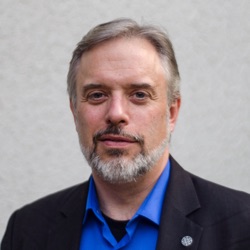Just a guy in Vermont trying to connect all the dots...
Author's posts
Jul 28
Connecting The Unconnected: The Story of a Visit to a School in Agua Azul, Mexico
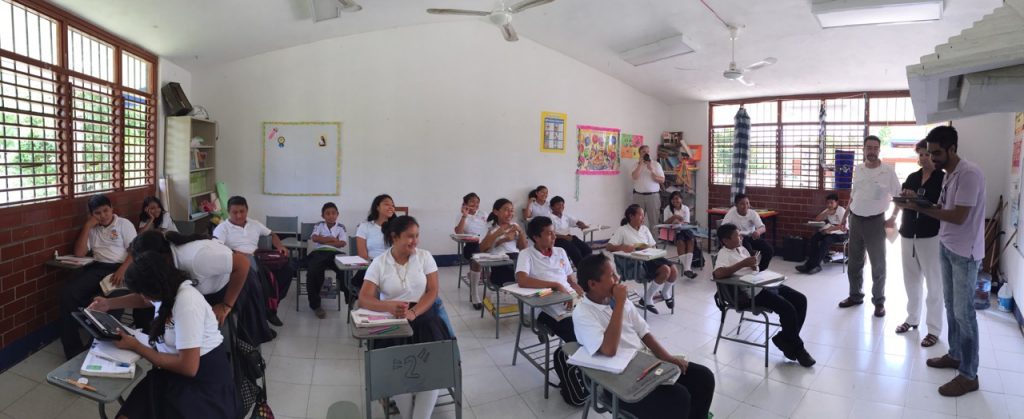
How do you bring the “Internet” to a remote village in Mexico that doesn’t even have phone service? On June 20, 2016, we set out to understand that question. It was the day before the start of the OECD Ministerial Meeting on the Digital Economy in Cancun,and our ISOC Mexico Chapter arranged for this visit.
Our group was small: Internet Society President & CEO Kathy Brown, Regional Bureau Director for Latin America Sebastián Bellagamba, Alejandro Pisanty of the ISOC Mexico Chapter and myself.

In a parking lot on the outskirt of Cancun we met Camilo Olea (pictured above on the right) and Pedro González. They are the founders of Kaanbal, a nonprofit organisation seeking to bring the Internet to remote regions of Mexico. They are also the recipients of an Internet Society “Beyond The Net” grant.
From there we drove about 60 kilometres west of Cancun to reach the small community of Agua Azul in the municipality of Lázaro Cardenas, Quintana Roo. It is about 450-500 people out in the jungle area of the Yucatan Peninsula.

After parking and visiting a local community centre, we walked down the road to the school. Two of the three classrooms were in session, and we visited both. There are about 120 students between the middle school and high school. The students come not only from Agua Azul but also at least five other nearby communities.

Despite the satellite dish shown on the roof of the school, there was no Internet access available. In fact, residents have to drive a good distance to a highway just to be able to send a text message.
The first step was for Pedro González to install a Raspberry Pi server configured with the RACHEL software distribution. The Pi connected to a WiFi access point. Instantly we were able to browse locally using the teacher’s laptop computer and the iPads we had brought with us.


This, then, was the answer to that first question – how do you bring the “Internet” to a place where there is no phone service?
In truth, we were bringing “Internet resources” to the community. The content of Wikipedia, a set of Khan Academy courses, books, medical and health guides, videos about how to play instruments, and so much more. RACHEL, short for Remote Area Community Hotspot for Education and Learning, is a project of World Possible to bring educational content out to communities such as Agua Azul.
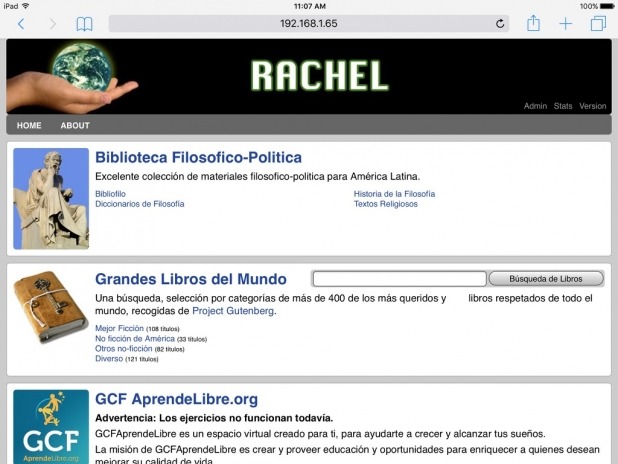
On a technical level, a RACHEL server is essentially a cached copy of a variety of websites. With storage space now being so cheap, a significant amount of web content can be shared. Obviously, you don’t have the real-time updates, but for educational material, this can be fine.
The RACHEL website lists the range of available content. Pedro and Camilo went through and identified the resources that they thought would be most helpful to the community. All of it is available in Spanish. They loaded those modules on the Pi server and brought it to the village.
It was powerful to watch the students as they interacted with sites such as Wikipedia that many of us simply take for granted.
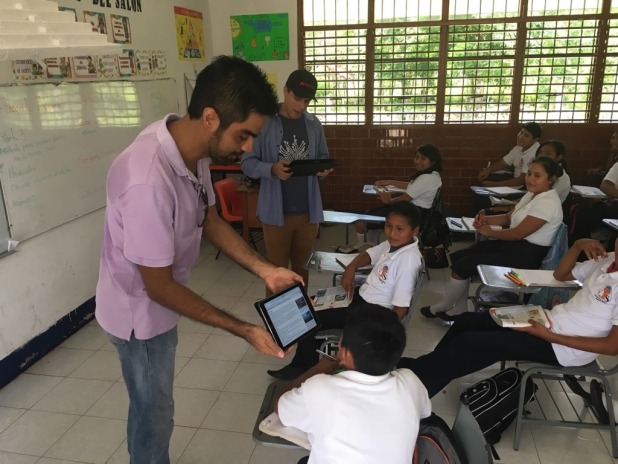
As an example, Kathy asked a few students to find information in Wikipedia about Virginia, where she lives and talked about where she was from. Next, she asked them to find and share with the rest of the class information about where they live in Mexico. Seeing their interest and enthusiasm made the trip worthwhile to me.
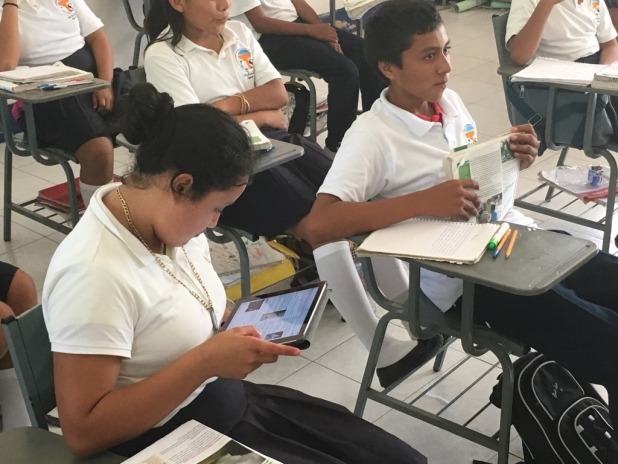
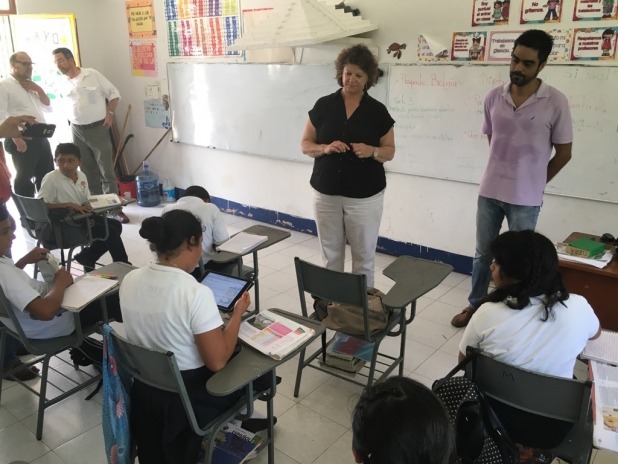
We didn’t stay too long. After all, school was in session! But we did get a good glimpse into the power of bringing resources from the Internet out to communities such as this.
Beyond the resources, I saw that this is preparing people for full Internet access. As these students tapped on the links and searched the available content, they were learning the skills that we use every day in the online world.
There was good news on that topic, too. It seems that a previous project to bring Internet access a few years earlier by a different group had left behind an installed radio tower at the school. Our team members from Kaanbal and ISOC Mexico recorded the necessary information about the tower location and height.
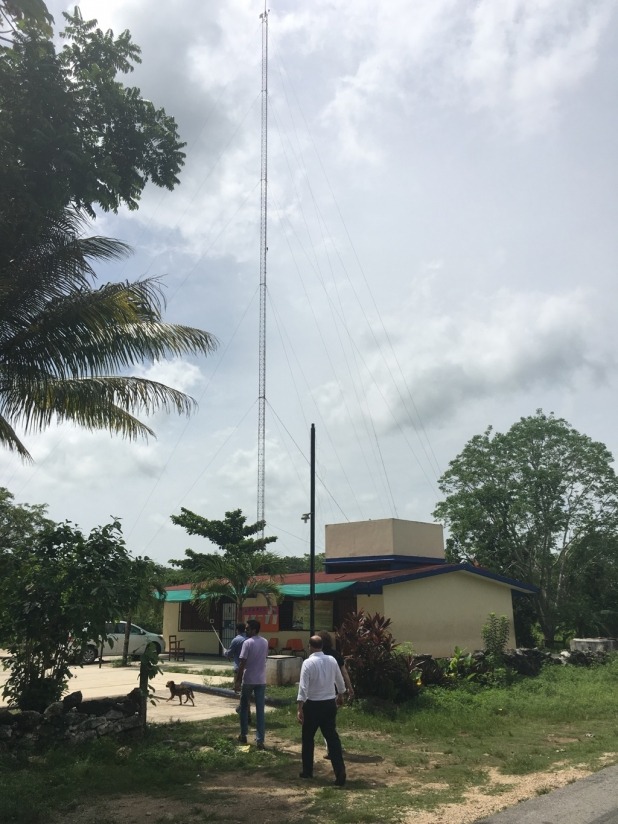
Their goal now is to find someone who can connect Agua Azul to the Internet using this tower. When they do, the students in the school will be ready!
Walking back to the cars, Pedro explained more about their efforts in Mexico. Already they’ve had interest from other communities. They are also working to tailor the software to the specific interests of the communities. For instance, Pedro and Camilo can collect feedback from teachers about what resources they need for upcoming lessons – and then bring updated software when they next visit.
As we drove back to Cancun for the start of the OECD Ministerial Meeting, I could only think of the subtitle of the event: “Innovation, Growth and Social Prosperity”.
Efforts like this are how we can bring about that growth and social prosperity. Material and content developed through the collaboration of many people across the open Internet. Software (RACHEL) and hardware (Raspberry Pi) created and developed by communities on the Internet. And then groups on the ground bringing that global information into local communities. Innovation and growth fueled by the remarkable creativity of collaboration.
THIS is how we bring the “Internet of Opportunity” to everyone!
More information:
- Internet Society Beyond The Net Funding Programme
- Internet Society works on Internet access issues
- Kaanbal
UPDATE: Camilo Olea provided a Spanish translation of this blog post.
UPDATE: Pedro González provided this video that gives another view into the visit:
The post Connecting The Unconnected: The Story of a Visit to a School in Agua Azul, Mexico appeared first on Internet Society.
Jul 27
Turning The Microphone Around: An Interview with Greg Ferro
Usually Greg Ferro is the one interviewing people. But at the recent Internet Engineering Task Force (IETF) 96 meeting in Berlin, Germany, I had the chance to turn the microphone around and ask Greg some questions of my own, including: What did he think of an IETF meeting now that he was at one? What […]
The post Turning The Microphone Around: An Interview with Greg Ferro appeared first on Packet Pushers.
Jul 26
Deadline of August 14 for Call for Presentations at DNS-OARC 25
 Do you have an idea about how to improve DNS that you would like to present to a community of people active with DNS? Have you done research into new ways to better secure DNS or increase the privacy? Have you done something with DNSSEC or DANE that you’d like to share with others?
Do you have an idea about how to improve DNS that you would like to present to a community of people active with DNS? Have you done research into new ways to better secure DNS or increase the privacy? Have you done something with DNSSEC or DANE that you’d like to share with others?
If so, the team over at the DNS Operations Analysis and Research Center (DNS-OARC) has issued their Call for Presentations for DNS-OARC 25. The DNS-OARC 25 meeting takes place on Saturday and Sunday, October 15-16, 2016, right before the NANOG 68 meeting.
The deadline to submit proposals is AUGUST 14, 2016.
To get a sense of the topics discussed in a DNS-OARC meeting, I would suggest viewing the list of contributions to DNS-OARC 24 in Montreal last October.
If you have an idea, please do submit a proposal – read the DNS-OARC CFP for all the details.
Jul 25
TDYR 309 – Trying A New Rule – No Social Media Usage Until I Have Created Something Online
Jul 24
Trying a New Rule – No Social Media Usage Until I Have Created Something New
No social network usage until I have created something online.
No Facebook. No Twitter. No Instagram... Ello... Google+... or anything else.
Nothing on any of those each day until I have done something such as:
- Published an article on one of my blogs / sites, including the ones for where I work.
- Published an episode on one of my podcasts.
- Done something else to add content online.
The issue is that I've noticed lately that I've been doing more consuming of content versus creating content.
And as I looked at why, I've noticed that I've been spending a longer time inside of social networks. Before I start my work day I'll fire up Facebook... and 30 or 40 minutes later I emerge. Or on a break I'll scan Twitter or Instagram... and... again time goes by.
Which isn't to say that Facebook / Twitter / Instagram / etc. aren't useful... they definitely are.
But I find I am letting them distract me into consumption of news, updates, etc., instead of creating my own.
So my little experiment is NOT to check any of those until after I've created some content in some form.
Now, I've given myself permission to "cheat" a little in that I might schedule several posts to go out in advance... but the point is to be publishing more than I am doing now.
We'll see how this goes...
Image credit: A few years ago Donna Papacosta posted a photo of this button on her Facebook page. I liked it so much that I printed it out and taped it up on the cross-bar of my office window so that every time I look up from my computer I see that image! The photo is of that image between the blinds that I have covering the window on sunny days.
UPDATE #1 - So on the second day I already failed... I was just getting going and had my phone open checking something else... and bam... I fired up Facebook and started surfing through my Newsfeed. Almost an unconscious action at this point! Will take some re-training to break this habit.
An audio version of this post is now available:
Jul 23
TDYR 308 – An Interview with Greg Ferro of Packet Pushers Podcast
Jul 22
TDYR 307 – Reflections on Judging the IETF96 Hackathon
Jul 16
TDYR 306 – A Great Day of Hacking At The IETF96 Hackathon
Jul 13
Rough Guide to IETF 96: DNSSEC, DANE and DNS Security
Once again, it looks like the most vigorous area of DNS security discussion at next week's IETF 96 meeting in Berlin may be in the Using TLS in Applications (UTA) working group. As was the case earlier this year at IETF 95 in Buenos Aires, the UTA working group is exploring different options for securing email communication. DNSSEC and DANE both feature to different degrees in some of the proposals.
Jul 13
Join the DNS Security team at the IETF 96 Hackathon this weekend…

If you will be in Berlin, Germany, this weekend and are interested in putting your coding or documentation skills to good use in helping make DNS more secure, please plan to join a group of about 20 of us at the IETF 96 Hackathon who will be working on DNS-related projects. The Hackathon is at the InterContinental Hotel from 9:00am – 9:00pm on Saturday, July 16, and from 9:00am – 6:00pm on Sunday, July 17. (You don’t have to be there the whole time – some people come and go.)
NOTE: you do NOT have to be attending IETF 96 to participate in the Hackathon. It is separate – and free – but you do need to register to attend. We welcome other developers in the Berlin area who want to join us during the weekend.
Details can be found on the IETF 96 Hackathon wiki page.
We have a group of 20+ people who will be working on a variety of DNS, DNSSEC, DPRIVE and DANE projects. There are some projects that could use some additional help (including non-coding help such as documentation and user testing). You are also welcome to bring other projects to the Hackathon.
You can see the list of projects and ideas on the IETF wiki hackathon page – although you need to scroll down to find the DNS section.
The GetDNS crew has a number of projects underway, including TLS interfaces, a Universal Acceptance review and RFC5011 testing. Rick Lamb plans to make BIND work with smartcards without patches. I plan to work on the code behind the weekly DNSSEC deployment maps. I’m sure others will bring some projects, too, by the time it begins.
A good group of “DNS people” have now done this for the past several IETF meetings. It’s been a great experience and moved a number of DNS-related projects forward. We would definitely welcome anyone else who wants to join us, even if just for part of the time. Bring your coding and documentation skills and help make DNS better!
P.S. And of course you can also join in with the many other excellent projects happening at the Hackathon, too, including some great work on TLS implementations. We here at Deploy360 just happen to be focused on DNS…

